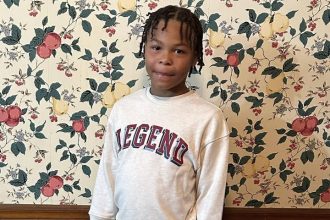CINCINNATI, OH — June 20, 2025 — Community Mourns Loss of 16-Year-Old in Fatal Over-the-Rhine Shooting as Cincinnati Faces Deepening Youth Violence Crisis
The city of Cincinnati is once again confronted with a heartbreaking tragedy following the fatal shooting of 16-year-old Rasheed Mills, a young life cut tragically short on Thursday night in the city’s historic Over-the-Rhine neighborhood. The fatal incident, which occurred in the 1300 block of Vine Street, has left the community devastated, and serves as a stark reminder of the growing crisis of youth violence that continues to afflict cities across the nation.
Local officials confirmed the teenager’s identity early Friday morning, and community members were quick to gather at the scene and across the city to express their grief, frustration, and demands for justice. The death of such a young individual — described by friends as hopeful, ambitious, and full of life — has sent shockwaves through schools, neighborhoods, and families.
The Shooting: A Night of Sudden Violence
According to preliminary reports from the Cincinnati Police Department, officers were dispatched to the area of Vine Street around 9:45 p.m. on Thursday after receiving multiple 911 calls reporting gunfire. When law enforcement arrived at the scene, they found a teenage male suffering from what appeared to be multiple gunshot wounds.
Emergency medical personnel responded immediately and began life-saving efforts at the scene. The victim was then transported to the University of Cincinnati Medical Center, where, despite the best efforts of medical teams, he was pronounced dead a short time later.
Witnesses described the aftermath as chaotic and emotionally charged. “There were people crying in the street,” said one local business owner. “We saw flashing lights, ambulances, and officers everywhere. It’s not something you ever get used to.”
No arrests have been announced at this time, and investigators are continuing to gather surveillance footage, canvass for witnesses, and appeal to the public for information that might help identify the suspect or suspects involved.
A Neighborhood Shaken
Over-the-Rhine, once one of the city’s most troubled areas, has in recent years seen a cultural and economic revitalization. Boutique restaurants, shops, and art spaces now line the historic district’s streets, but the area still struggles with pockets of poverty, housing insecurity, and gun violence — especially among young people.
The fatal shooting of a teenager in such a public and populated area has rattled both longtime residents and new arrivals. Many say the death is a reminder that beneath the surface of gentrification lies unresolved systemic issues — poverty, lack of opportunity, and insufficient youth support systems.
“This neighborhood has come so far in so many ways,” said a local pastor. “But violence like this reminds us that we haven’t come far enough when our kids are still dying in the streets.”
Civic leaders are now grappling with the dual realities of progress and pain, as they call for a renewed commitment to addressing the root causes of violence and preventing future tragedies.
Who He Was: A Promising Life Cut Short
As the city learns more about the young victim, the collective heartbreak deepens. Friends, teachers, and community members have begun sharing stories about who the 16-year-old was — not just as a victim, but as a son, student, and dreamer.
He was reportedly a high school junior who had recently begun exploring career options. He loved music, played pickup basketball with friends at a nearby court, and had ambitions of going to college or starting his own business. Family members describe him as a “protector,” someone who often looked after younger siblings and stood up for his friends.
“He had the brightest smile,” one teacher said. “Even when he was struggling, he tried to uplift everyone around him. He had so much potential.”
In the days to come, a vigil will be held at the spot where he was shot. Neighbors plan to light candles, release balloons, and share memories to honor his life and to send a message that his death will not be forgotten.
Youth Gun Violence in Cincinnati: A Growing Crisis
This tragic shooting adds to an alarming pattern of youth violence that has plagued Cincinnati in recent years. According to data from local law enforcement and public health agencies, gun-related homicides involving minors have increased significantly since 2021, with a troubling rise in both victims and perpetrators under the age of 18.
The root causes of this surge are complex — ranging from economic inequality and lack of access to mental health care to the easy availability of firearms and the presence of local gang activity. Many experts emphasize that simply increasing policing is not enough. Holistic, community-based solutions are needed to address the cycle of violence that ensnares so many young people.
“This is not just about crime,” said a community activist. “This is about a generation that feels unheard, unsupported, and unsafe. We need to show them there are other paths.”
Programs aimed at violence interruption, conflict resolution, mentorship, and trauma recovery have gained traction in several neighborhoods, but advocates say they are underfunded and often overwhelmed by demand.
City Leaders, Families, and Advocates Respond
In the wake of the shooting, Cincinnati Mayor and Police Chief both issued statements expressing condolences and vowing to pursue justice swiftly and thoroughly. Community leaders, meanwhile, are urging a broader and deeper conversation about the kind of environment the city is providing for its youth.
Several grassroots organizations have called for emergency meetings and town halls to discuss gun access, school safety, and the availability of resources for at-risk youth. Local nonprofits are also organizing crisis counseling and mental health support for students and peers affected by the loss.
“We can’t normalize this,” said a youth program director. “We can’t keep reacting with outrage and then returning to silence. We owe it to this young man and every other child we’ve lost to do better.”
Some have proposed more stringent citywide curfews for minors, while others caution against punitive responses that may not address the deeper problems.
Remembering and Rebuilding
As the community prepares to say goodbye to a life lost too soon, there is also a sense of urgency — an understanding that action must follow grief. That his name not be added to the list of forgotten victims, but instead become a catalyst for change.
“We will remember him,” said a community member organizing Saturday’s vigil. “But more than that, we will honor him — by fighting for our kids, by creating safer neighborhoods, by giving them a future they can believe in.”
Local schools are also preparing for the emotional toll this event will have on students and staff. Crisis response teams will be deployed to his high school, and teachers are being encouraged to create space for students to express their emotions.
A GoFundMe campaign has been launched to support the victim’s family with funeral expenses and to help relocate siblings temporarily shaken by the trauma.
Looking Ahead
Though the investigation into the shooting remains ongoing, the larger story is already being written in the hearts of those who mourn — and in the policies and programs that may follow. It is a story of grief, yes, but also of collective responsibility and the hope that something better is still possible for the next generation.
The loss of a 16-year-old in the streets of a city that claims to protect him is not just a tragedy — it is a failure. And yet, it is also an opportunity: to listen, to act, and to commit to ensuring that such violence no longer defines the lives of Cincinnati’s youth.
In Over-the-Rhine, the candles will burn, the balloons will rise, and the community will gather — not only in mourning but in resolve. Because this time, they say, things must change.
If you have any information regarding the shooting, contact Cincinnati Police’s Homicide Unit at (513) 352-3542 or report anonymously through Crime Stoppers at (513) 352-3040.




